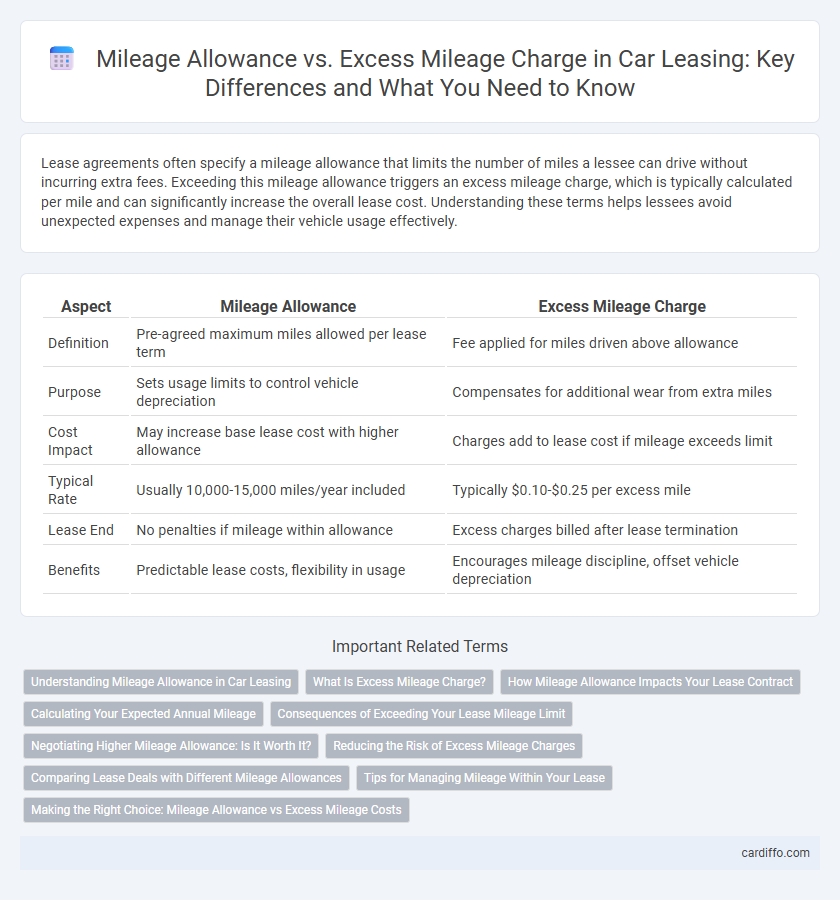Lease agreements often specify a mileage allowance that limits the number of miles a lessee can drive without incurring extra fees. Exceeding this mileage allowance triggers an excess mileage charge, which is typically calculated per mile and can significantly increase the overall lease cost. Understanding these terms helps lessees avoid unexpected expenses and manage their vehicle usage effectively.
Table of Comparison
| Aspect | Mileage Allowance | Excess Mileage Charge |
|---|---|---|
| Definition | Pre-agreed maximum miles allowed per lease term | Fee applied for miles driven above allowance |
| Purpose | Sets usage limits to control vehicle depreciation | Compensates for additional wear from extra miles |
| Cost Impact | May increase base lease cost with higher allowance | Charges add to lease cost if mileage exceeds limit |
| Typical Rate | Usually 10,000-15,000 miles/year included | Typically $0.10-$0.25 per excess mile |
| Lease End | No penalties if mileage within allowance | Excess charges billed after lease termination |
| Benefits | Predictable lease costs, flexibility in usage | Encourages mileage discipline, offset vehicle depreciation |
Understanding Mileage Allowance in Car Leasing
Mileage allowance in car leasing defines the maximum distance a lessee can drive without incurring additional fees, typically specified as miles or kilometers per year in the contract. Exceeding this limit triggers excess mileage charges, which are calculated based on a predetermined rate per extra mile or kilometer driven. Understanding the mileage allowance helps lessees manage their usage to avoid costly penalties and maintain lease affordability.
What Is Excess Mileage Charge?
Excess Mileage Charge is a fee imposed when a vehicle exceeds the agreed-upon mileage limit in a lease contract. This charge compensates the lessor for the additional wear and tear and depreciation caused by driving beyond the preset allowance. Understanding this fee is crucial to avoid unexpected costs and manage lease expenses effectively.
How Mileage Allowance Impacts Your Lease Contract
Mileage allowance sets the maximum number of miles you can drive within the lease term without incurring extra fees, directly influencing your monthly payments and overall contract cost. Exceeding the mileage allowance results in an excess mileage charge, calculated per mile, which can significantly increase your lease expense. Understanding and accurately estimating your mileage needs helps avoid unexpected charges and maintain favorable lease terms.
Calculating Your Expected Annual Mileage
Calculating your expected annual mileage accurately is essential for managing lease costs effectively, as most vehicle leases include a predetermined mileage allowance, typically between 10,000 to 15,000 miles per year. Exceeding this mileage results in an excess mileage charge, often ranging from 10 to 25 cents per additional mile, which can significantly increase the total lease expense. Estimating your driving habits upfront helps avoid unexpected fees and ensures the lease agreement aligns with your actual usage.
Consequences of Exceeding Your Lease Mileage Limit
Exceeding your lease mileage limit typically results in an excess mileage charge, which is a predetermined fee per mile over the agreed limit, often ranging from 10 to 25 cents. This additional cost can significantly increase the total cost of your lease and may impact your budget planning. Maintaining mileage within the allowance helps avoid these penalties and preserves the residual value of the vehicle at lease-end.
Negotiating Higher Mileage Allowance: Is It Worth It?
Negotiating a higher mileage allowance can prevent costly excess mileage charges typically ranging from 10 to 25 cents per mile, depending on the lease agreement and vehicle type. For drivers exceeding 12,000 to 15,000 miles annually, increasing the mileage cap upfront often proves more economical than paying exorbitant fees at lease-end. Evaluating your driving habits and comparing lease terms ensures the mileage allowance aligns with actual use, maximizing financial benefits during lease tenure.
Reducing the Risk of Excess Mileage Charges
Implementing a mileage allowance that closely matches your actual driving habits helps reduce the risk of excess mileage charges on lease agreements. Tracking your mileage regularly and adjusting your driving to stay within the agreed limits prevents costly penalties at lease end. Choosing a lease plan with flexible mileage options or purchasing additional miles upfront offers financial predictability and minimizes unexpected excess mileage fees.
Comparing Lease Deals with Different Mileage Allowances
When comparing lease deals with different mileage allowances, understanding mileage allowance versus excess mileage charge is critical for accurate cost evaluation. Lease agreements typically include a set annual mileage limit; exceeding this limit results in excess mileage charges calculated per mile, significantly impacting the total lease cost. Opting for a higher mileage allowance upfront can reduce excess charges, providing better value for drivers with higher annual mileage needs.
Tips for Managing Mileage Within Your Lease
Tracking your mileage regularly helps avoid exceeding the contract limits and incurring costly excess mileage charges. Opt for route planning apps to minimize unnecessary driving and optimize fuel efficiency during your lease term. Consider negotiating a higher mileage allowance upfront if you anticipate extensive travel to prevent penalties and additional fees at lease end.
Making the Right Choice: Mileage Allowance vs Excess Mileage Costs
Selecting the appropriate mileage allowance in a lease agreement directly impacts financial outcomes by balancing upfront costs and potential excess mileage charges. Understanding the vehicle's typical annual usage helps determine whether a higher mileage allowance reduces expensive overage fees, optimizing total lease expenses. Carefully analyzing driving habits against mileage limits ensures cost-effective lease management and prevents unexpected charges at contract end.
Mileage Allowance vs Excess Mileage Charge Infographic

 cardiffo.com
cardiffo.com